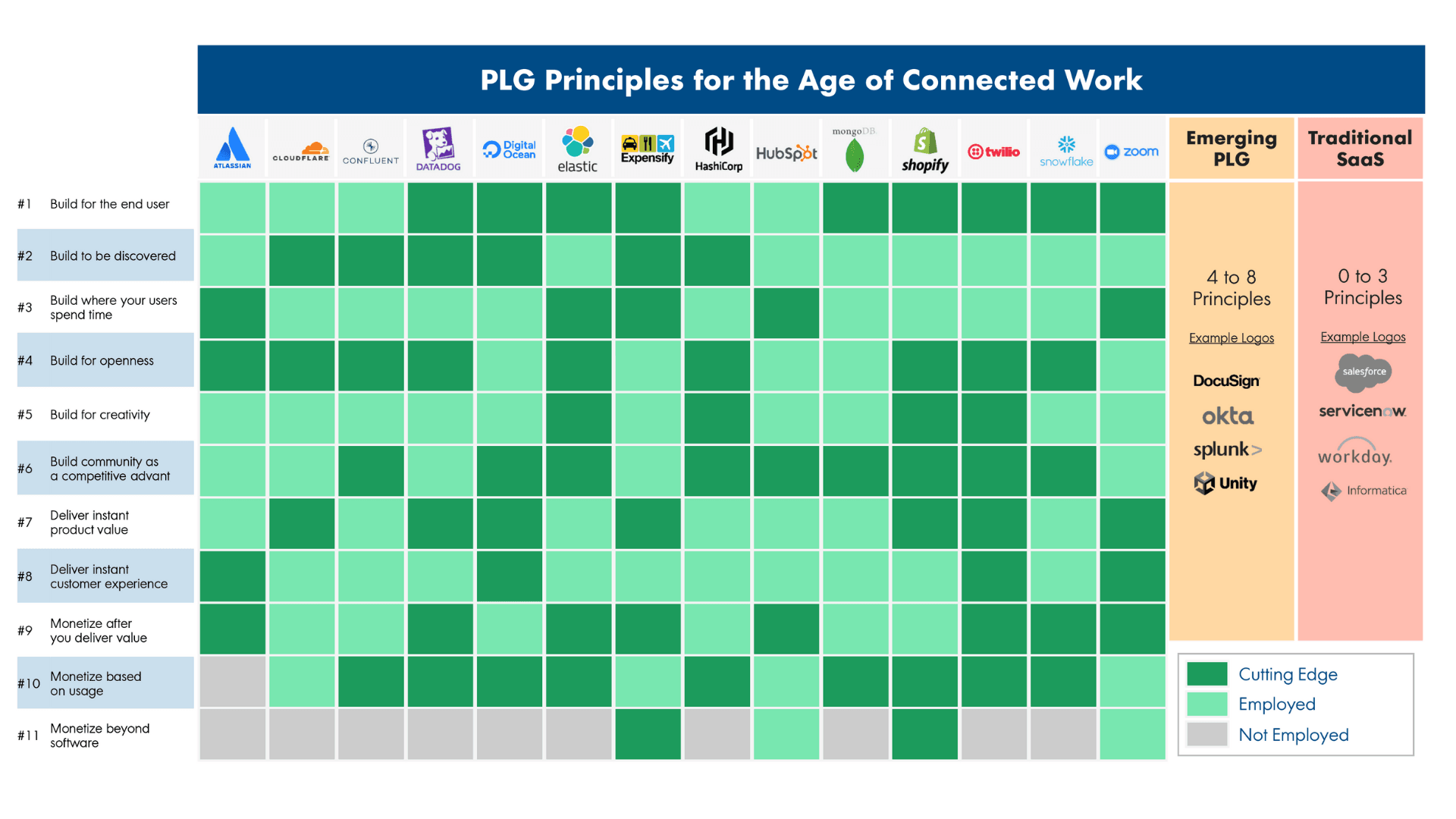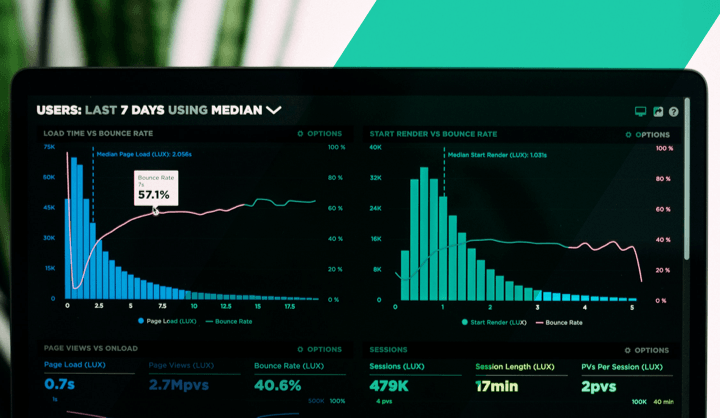Updated: December 5, 2024- 11 min read
Over the last decade, the “consumerization” of IT and SaaS explosion has meant that many companies now find their customers using a combination of tactics known as product-led growth strategy. It all started with a few efficient disruptors who gained traction through a bottom-up or “freemium” model. Many end users weren’t finding out about their new favorite product through an ad or cold call but through word of mouth or a Google search.
Before relatively recently, consumers couldn’t just open a browser and type their most pressing desire. Once they could, however, it only made sense that they would take a free tour of a new solution and sign up for its free plan. In 2016, OpenView Venture Capital convened a working group in 2016 to study this phenomenon and coined the term "product-led growth" to describe it.
OpenView partner Kyle Poyar compared their process of coming up with a name to that of a comedian working new material:
We had so many debates about not only names, but also what the core tenants were, what was required to be product-led… [My colleague] Blake Bartlett would start using terms in emails to founders or…on a podcast. Just like a stand-up comedian goes to tons of open mics and tests how the audience will respond to a joke, that's what we had to do to pick a name that would really work.
Growth Metrics Cheat Sheet
Master the metrics you need to keep things moving 'up and to the right'! Our Growth Metrics Cheat Sheet covers 45 metrics to measure success at every stage—from acquisition to revenue and referral.
Get the Cheat Sheet
Characteristics of Top PLG Companies’ Product-led Growth Strategies
Product-led growth’s secret weapon is its scalability. It depends less on sales and marketing reps and more on a user-driven process that works the same for one person as for 1,000. Of course, many PLG SaaS companies also have sales and marketing, not to mention developers and customer success teams. However, the strategy lends itself to a lean, agile way of working.
No PLG strategy is exactly the same, but most share several key characteristics:
Seamless sign-up process
Product features leverage growth loops to promote virality
Deliver immediate value (minimize TTV - Time to Value)
Freemium or free trial model to deliver immediate value
Prioritize end-user experience and user retention
Iterate on user feedback to enhance user satisfaction and drive organic growth

Image from OpenView Partners
Product Experimentation Certification
Scale growth through data-driven testing. Use AI to optimize acquisition, retention, pricing, and build a culture of high-velocity experiments.
Enroll now
The Rise of the Product Team
It only makes sense that companies embracing PLG changed the way stakeholders perceived product. PLG elevated product teams’ prestige and increased the need for collaboration between business and product functions. In turn, companies have created a plethora of product roles that work with everyone from the developers to the CEO.
As Product School’s CEO Carlos Gonzales de Villaumbrosia noted in the 2024 Future of Product Report, Product has a seat at the table like never before.

PLG in a post “Growth at All Costs” era
It bears mentioning that the perception of product-led growth strategies, particularly in the context of prioritizing growth over profitability at (in)famous product-led growth startups, has been a subject of discussion in recent times. According to TechCrunch, among public tech companies, PLG companies have been observed to operate at about 5% to 10% less profitability compared to those with sales-led motions. This has been attributed to PLG companies spending more as a percentage of revenue, especially on R&D).
In response, some have adopted a product-led sales strategy or what McKinsey calls “the best of both worlds.” At Product School, we have noted a trend of product teams embracing revenue and taking responsibility for business outcomes.
10 Product-Led Growth Examples
The best way to transform your strategy is by learning from the best. As the past decade's scrappy PLG startups and pivots have become established strategies, we all stand to benefit from looking at these successful PLG examples.
Product Strategy Template
The higher you go up on the Product career ladder, the more strategic skills matter. This template helps you define the why and how of product development and launch, allowing you to make better decisions for your users, team, and company.
Download Template
1. Grammarly: May the Best Product Win
Grammarly CEO Brad Hoover says that the path to success comes down to “building an exceptional product. You build an exceptional product by focusing on your users and their problems.”
Their strategy involves a deep understanding of user needs and the creation of a frictionless onboarding experience, which includes intuitive product tours that make the product's features easily understandable.
By making something as difficult as writing easier for users from the moment they start using the product, Grammarly ensures users quickly realize the value of their offerings, enhancing the likelihood of long-term adoption and loyalty.
2. Hubspot: Best Pivot to PLG
Hubspot didn’t start out as a PLG SaaS company. However, they saw the success of other product-led companies and decided to make a significant cultural shift that included adopting a customer's perspective in transitioning to PLG to ensure clear communication and new incentive structures for sales teams.
By providing an exceptional onboarding experience, HubSpot ensures users quickly understand and extract value from its CRM platform. HubSpot's product-led onboarding approach to product-led growth (PLG) is deeply rooted in intentional effort and cross-departmental alignment. Their strategy underscores the necessity of anticipating user needs and configuring the CRM to suit those needs effectively.
They still use sales reps to sell to high-ticket enterprise customers, but a lot of those customers find their way to HubSpot organically through their product-led approach.
3. ClickUp: User Feedback and Versatility
ClickUp has made significant strides in the productivity software landscape, leveraging product-led growth to expand its reach and enhance user satisfaction. Central to ClickUp's growth is its commitment to incorporating user feedback into continuous product development, ensuring the platform remains versatile and aligned with user needs.
This user-focused approach has allowed ClickUp to rapidly iterate on its offerings, adding features and integrations that broaden its appeal across various user segments. The platform's versatility is not just in its feature set but in its adaptability to different workflows, making it a preferred tool for teams seeking customization and efficiency in their operations.
4. Figma: Virality Through Collaboration
Figma's journey in the design world exemplifies the power of a product-led growth strategy centered around collaboration. Figma focused on collaborative features, allowing multiple users to work on a single file simultaneously.
Figma set itself apart in a competitive market by fostering a community of users who could seamlessly collaborate in real-time, regardless of their physical location. The more people use Figma, the more people bring in new users by sending out invites to collaborate.
In the world of product-led growth, this is what’s known as a viral acquisition loop.
According to Forbes:
Once a viral loop takes off, there's zero marginal cost to acquire new customers.
5. Zapier: Product-led SEO
Like the other companies on this list, Zapier has emphasized user engagement and a friendly onboarding process to make adoption smooth and delight customers. The thing that sets them apart is their SEO strategy, which has solidified Zapier's position as a leader in the automation space.
By promoting their integrations through content and SERP results, Zapier educated potential customers on a product they didn’t even know they needed. This back-door approach that targets high-volume keywords earned Zapier millions of monthly unique visitors and will go down in Product-led SEO history.
6. Zoom: Frictionless Communication
Zoom is probably the most popular example that the best product wins. Despite free and unlimited offerings from Google (Meet) and Microsoft (Teams), Zoom has been able to win more than 40% market share simply because people like using it more.
— SC Moatti, Founding Manager at Mighty Capital and CEO of Products that Count, quoted in TechCrunch
Zoom's PLG strategy is anchored in the simplicity and reliability of its video conferencing platform. Its user-friendly interface and seamless onboarding ensured that users could quickly realize the value of its service, leading to widespread organic growth.
Zoom’s simple mission statement says it all: Make video communications frictionless.
This approach, combined with strategic market positioning enabled Zoom to meet the surge in demand for reliable digital communication tools, particularly highlighted during the global shift to remote work. However, as Forbes points out, Zoom was already expanding fast before a global pandemic made it an essential service.
It’s worth pointing out that Zoom’s laser focus on user experience did leave something to be desired in other areas like security. But this isn’t an article about product-led security…
7. SurveyMonkey: Viral Marketing
SurveyMonkey is a must for any PLG companies list because of its mastery of product-led marketing tactics. Here's how it works:
Anyone who completes a SurveyMonkey survey is introduced to the product.
The surveys are so easy to complete and aesthetically pleasing that the experience of filling one out does more than an ad at a bus stop ever could.
This tactic covers the first A in AAARRR, sometimes called the Pirate (as in, Aaarrr, matey) Funnel:
A | Awareness ●●●●●●●●●●
A | Acquisition ●●●●●●●●
A | Activation ●●●●●●
R | Retention ●●●●
R | Revenue ●●●
R | Referral ●●
What’s brilliant about SurveyMonkey’s strategy is that users trigger the Referral level as high as the activation stage when sending their first survey.
8. Calendly: A market match made in heaven
Calendly is considered one of the best product-led growth companies for the simple reason that it solves a nearly universal headache: scheduling.
“Can you come in on Monday at one of the following times?...”
“I’m afraid I’m out of town all next week, but would the following Thursday afternoon…”
“We can do Thursday morning or Friday afternoon, would either of those…”
Help! No, no, life is just too short for that nonsense. The fact that no matter who you are, those three hypothetical sentences most certainly sent your heart racing is what PLG experts call product-market fit.
In addition to eliminating a process as popular as mosquito bites, Calendly employs product-led marketing tactics like SurveyMonkey does: Anyone who schedules an appointment with Calendly gets a little taste of the product, working that Pirate Funnel.

9. Slack: Leveraging Product-led Growth for Enterprise Clients
Similar to Calendly, Slack seized on an opportunity to free people of something dysfunctional: email. Slack promises to get people out of their cacophonous inboxes and onto a pleasant platform that makes starting a conversation with anyone at your organization a breeze.
Slack’s freemium lends itself to enterprise adoption as individual users whose TTV (Time to Value) is minimal do the work of convincing decision-makers to purchase a paid version for the entire company.
10. Dropbox: Spurring Growth Through Referrals
Dropbox was a PLG company from the get-go. The service began by addressing a prevalent issue—cumbersome file-sharing methods like FTP and local servers—with a user-friendly, drag-and-drop interface accessible from anywhere.
To enhance its virality, Dropbox introduced features that encouraged users to share the product with others. For example, the shared folders feature allowed seamless document synchronization, fostering collaborative workflows directly within Dropbox.
While TTV was kept to a minimum by not requiring an account to access shared files, a referral program incentivized users to invite others by offering extra storage space for each new signup. This turned users into brand ambassadors as soon as they hit the generous but reachable 2 GB limit.
Today, perks from a referral program are almost expected. However, when Dropbox started, this was still a new strategy. Traditional products don’t necessarily lend themselves to referrals. If you recommend a frying pan to a friend, you don’t get anything besides the satisfaction of knowing they’ll forever respect your taste in cookware.
It took digital-first companies a moment to realize that they could, and should, turn their users into marketers. And today, if your new frying pan comes with a QR code that your friends can scan to get you points toward a new panini press, it’s because of companies like Dropbox.
In business, the pendulum swings between the two poles of growth and profit. However, there’s no mistaking that the past 10 years have seen a seismic shift in strategy that has elevated product to never-before-seen heights. The ad men and wolves of Wall Street have had to make room for today’s Product Leaders. The best product-led companies might not be on this list—they may not exist yet. That is the exciting aspect of product-led growth. There’s always room for more.
Product-Led Growth Micro-Certification (PLGC)™️
Experience the game-changing potential of Product-Led Growth (PLG) as it revolutionizes the role of Product Managers and their impact on organizations.
Enroll now for free
Updated: December 5, 2024


